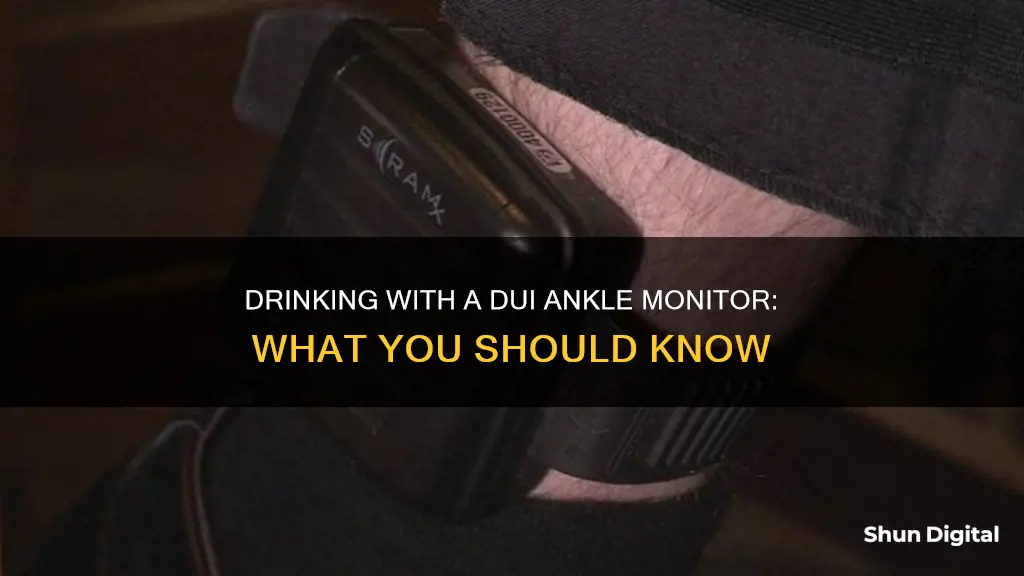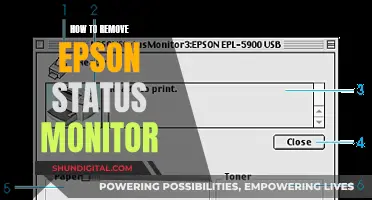
If you've been arrested for a DUI, you might be required to wear an ankle monitor to track your alcohol intake. These devices, known as SCRAM (Secure Continuous Remote Alcohol Monitor) bracelets, are court-ordered and used to monitor a DUI defendant's alcohol consumption by testing their perspiration every 30 seconds to 30 minutes. While it is possible to drink alcohol while wearing a SCRAM bracelet, it is not recommended as it can result in further penalties such as jail time, fines, and prolonged probation. Additionally, attempting to tamper with or remove the device will also result in additional penalties.
| Characteristics | Values |
|---|---|
| Name | SCRAM (Secure Continuous Remote Alcohol Monitor) |
| Type of device | Bracelet |
| Where worn | Ankle |
| Alcohol detection | 24/7 |
| Alcohol detection method | Monitoring sweat every 30 minutes to 30 seconds |
| Installation fee | $50 to $100 |
| Daily monitoring fee | $10 to $15 |
| Monthly cost | Up to $450 |
| Removal consequences | Alert sent to regional monitoring centre; punishment such as harsh sentencing or longer probation |
| Alcohol-containing products to avoid | Perfume, lotions, mouthwash, hand sanitiser, food, soap, etc. |
What You'll Learn
- The SCRAM bracelet tests your sweat for alcohol content every 30 minutes
- It's almost impossible to trick the SCRAM bracelet
- If you tamper with the SCRAM bracelet, you will face serious consequences
- You will have to pay for the SCRAM bracelet yourself
- You can still live a normal life while wearing a SCRAM bracelet

The SCRAM bracelet tests your sweat for alcohol content every 30 minutes
The SCRAM bracelet, short for Secure Continuous Remote Alcohol Monitor, is a device that is worn on the ankle 24 hours a day and is part of some DUI sentences. It is designed to monitor your sweat for alcohol content every 30 minutes, providing round-the-clock transdermal alcohol testing. This means that even low levels of alcohol consumption can be detected by the bracelet.
The SCRAM bracelet is fitted securely to the lower leg, just above the ankle, and is designed to be worn at all times. It works by testing the wearer's perspiration, or sweat, which contains traces of alcohol after drinking. This process of testing through the skin is known as transdermal alcohol testing and is an entirely non-invasive way to detect alcohol consumption. The device then automatically transmits the testing data wirelessly to a base station, where it is stored and uploaded for monitoring.
The SCRAM bracelet's continuous monitoring eliminates testing gaps and makes it difficult for the wearer to drink without detection. It also distinguishes between alcohol consumption and external environmental sources of alcohol, such as the use of alcohol-containing products. This is achieved by detecting a sudden peak in alcohol readings, which indicates an environmental factor, as opposed to a gradual increase in readings when drinking alcohol.
The SCRAM bracelet is an effective tool for courts to monitor offenders who are not supposed to be drinking alcohol, especially in cases of driving under the influence (DUI). It provides accountability and encourages compliance with court orders, increasing community safety. The data collected by the bracelet can be used in legal settings, with courts deeming the evidence of alcohol consumption and tampering as reliable and admissible.
Troubleshooting an ASUS 144Hz Monitor Not Reaching 144Hz
You may want to see also

It's almost impossible to trick the SCRAM bracelet
Some people may attempt to create a barrier between the skin and the monitor, such as using plastic wrap or rubber gloves. However, this method is unlikely to be effective as the SCRAM bracelet detects alcohol vapour liberated by the skin. Others may try to interfere with the signals transmitted by the device, such as by using a Faraday cage or signal jammers, but this will only provide temporary relief. The SCRAM bracelet is designed to detect any tampering attempts, and any interference with the device will be reported to the courts and the individual's probation officer, resulting in serious consequences.
One theory suggests using a desiccant material, like silica gel, to absorb the alcohol vapour before it can be detected by the SCRAM bracelet. However, this method is unlikely to work for more than a few hours, and it requires constant monitoring and replacement of the desiccant material. Additionally, any attempt to tamper with the device, such as by sealing it or blocking the sensors, will likely be detected as an abnormal transpiration condition, triggering an alert.
The most effective way to "beat" a SCRAM bracelet is to refrain from consuming alcohol altogether. The device is designed to accurately detect and measure alcohol consumption, and any attempts to evade detection will likely result in negative consequences. It is important to prioritise sobriety and comply with the monitoring program to meet legal requirements and maintain personal well-being.
Asus Monitor Brightness: Optimal Settings for Eye Comfort
You may want to see also

If you tamper with the SCRAM bracelet, you will face serious consequences
The SCRAM bracelet is designed with two sides, one for the ethanol sensor and the other for tamper-resistant technologies. The tamper clip secures the bracelet to your ankle, and if removed, it must be destroyed. The bracelet also has an infrared sensor that shines a beam of light against your skin and sets a baseline reading. If this reading varies, it indicates that something has been placed between your ankle and the bracelet, triggering an alert.
Additionally, the SCRAM bracelet has a temperature sensor that monitors temperature readings. Any significant variance in temperature may suggest that you attempted to tamper with the device by placing an object between your skin and the bracelet. Obstruction usually results in lower temperature readings. The bracelet also has a small electrical signal that continuously passes through the strap, so if you cut the strap, the signal is interrupted, indicating tampering.
If you are found to have tampered with the SCRAM bracelet, you may face severe legal consequences, including criminal charges. It is essential to comply with the terms of your supervision or probation and refrain from any actions that could lead to legal repercussions.
Monitoring Resource Usage: Strategies for Efficient Startup Management
You may want to see also

You will have to pay for the SCRAM bracelet yourself
If you are court-ordered to wear a SCRAM bracelet and are unable to afford it, you may be able to extend your probation period and make smaller weekly payments. You could also file a motion to modify your sentence or waive costs. Some judges may be open to waiving the costs or considering alternative methods of tracking if you can demonstrate a financial hardship. However, this is not guaranteed, and you may still be required to pay for the SCRAM bracelet yourself.
The cost of a SCRAM bracelet includes a one-time installation fee, which is typically between $50 and $100, and daily monitoring fees, which can be around $10 to $15 per day. This means that the monthly cost of a SCRAM bracelet can be as high as $450 or more. While this may seem expensive, it is important to consider the potential cost of jail time and fines if you do not comply with the court's requirements.
If you are facing financial difficulties and cannot afford the SCRAM bracelet, it is essential to seek legal advice. Consult with a criminal defense attorney who specializes in DUI cases or a local attorney familiar with the judge who sentenced you. They can guide you through the process and help you explore your options, such as modifying your sentence or seeking alternative arrangements.
It is important to remember that the consequences of non-compliance with the court's requirements can be severe. If you are unable to pay for the SCRAM bracelet and do not have a valid alternative in place, you may face additional legal charges or an extension of your monitoring period. Therefore, it is in your best interest to work with a legal professional to find a solution that complies with the court's orders and addresses your financial situation.
Removing Continuous Glucose Monitors: A Step-by-Step Guide
You may want to see also

You can still live a normal life while wearing a SCRAM bracelet
A SCRAM bracelet, or Secure Continuous Remote Alcohol Monitor, is a device used to monitor an individual's alcohol consumption. It is typically worn on the ankle and is often court-ordered for those facing DUI charges or who are on probation or parole. The device works by sampling the wearer's perspiration every 30 minutes to detect the presence of alcohol. While wearing a SCRAM bracelet may feel like a significant change to your life, it is possible to adapt and continue living a normal life while ensuring your compliance with the court's requirements. Here are some ways you can maintain a sense of normalcy:
Understand the Purpose of the SCRAM Bracelet:
Recognize that the SCRAM bracelet is not meant to punish you but to help you maintain your sobriety and comply with court orders. It provides accountability and encourages long-term behavior change, supporting your journey towards alcohol dependence or addiction recovery.
Maintain a Regular Routine:
Continue with your daily activities as much as possible. Go to work, school, or any other commitments you usually have. This sense of routine can help you feel more in control and grounded during this time.
Seek Support:
Reach out to your support system, including friends and family who can provide encouragement and help you stay focused on your recovery goals. Consider joining support groups or seeking counseling to help you through this challenging time.
Comply with Regulations:
It is crucial to follow the rules and guidelines provided by the court and the monitoring agency. This includes adhering to check-in and testing requirements. Any attempts to tamper with or remove the device will result in legal consequences. Complying with the program demonstrates your commitment to your recovery and can enhance your chances of a successful outcome.
Practice Self-Care:
Take care of yourself both physically and mentally. Eat healthily, exercise, and get enough sleep. Find healthy ways to manage stress, such as meditation or journaling. Remember that this is a temporary situation, and taking care of yourself will give you the strength to get through it.
While wearing a SCRAM bracelet may initially feel restrictive, it is important to remember that it is a tool to help you maintain your sobriety and comply with legal requirements. By following the above suggestions, you can continue living a normal life while working towards a positive future.
How Long Do LCD Monitors Typically Last?
You may want to see also
Frequently asked questions
DUI ankle monitors, also known as SCRAM (Secure Continuous Remote Alcohol Monitor) devices, are alcohol-monitoring ankle bracelets that detect and report the wearer's alcohol consumption. They are usually court-ordered for repeat DUI offenders or those deemed high-risk.
The SCRAM device monitors the wearer's perspiration for alcohol content every 30 seconds to 30 minutes. It then transmits the data to a computer database, which is eventually processed and sent to the courts.
No, you must commit to going completely alcohol-free while wearing a DUI ankle monitor. Any attempts to drink alcohol will be detected and reported to the courts, resulting in serious consequences.
Tampering with or attempting to remove the DUI ankle monitor will be reported to the courts as a violation of your probation. This can result in additional penalties such as jail time, fines, or prolonged probation.
The duration of wearing the DUI ankle monitor depends on the facts of your case, including the seriousness of the offense, the number of prior DUI convictions, and the extent of your problem with alcohol. Typically, the period can range from 30 days to more than a year.







